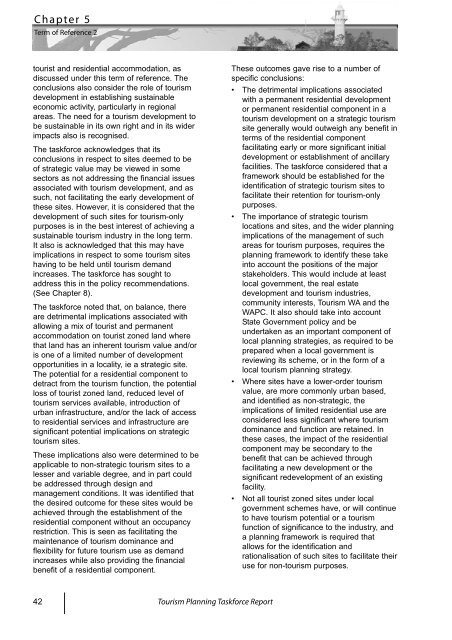Tourism Planning Taskforce Report - Western Australian Planning ...
Tourism Planning Taskforce Report - Western Australian Planning ...
Tourism Planning Taskforce Report - Western Australian Planning ...
- No tags were found...
Create successful ePaper yourself
Turn your PDF publications into a flip-book with our unique Google optimized e-Paper software.
Chapter 5Term of Reference 2tourist and residential accommodation, asdiscussed under this term of reference. Theconclusions also consider the role of tourismdevelopment in establishing sustainableeconomic activity, particularly in regionalareas. The need for a tourism development tobe sustainable in its own right and in its widerimpacts also is recognised.The taskforce acknowledges that itsconclusions in respect to sites deemed to beof strategic value may be viewed in somesectors as not addressing the financial issuesassociated with tourism development, and assuch, not facilitating the early development ofthese sites. However, it is considered that thedevelopment of such sites for tourism-onlypurposes is in the best interest of achieving asustainable tourism industry in the long term.It also is acknowledged that this may haveimplications in respect to some tourism siteshaving to be held until tourism demandincreases. The taskforce has sought toaddress this in the policy recommendations.(See Chapter 8).The taskforce noted that, on balance, thereare detrimental implications associated withallowing a mix of tourist and permanentaccommodation on tourist zoned land wherethat land has an inherent tourism value and/oris one of a limited number of developmentopportunities in a locality, ie a strategic site.The potential for a residential component todetract from the tourism function, the potentialloss of tourist zoned land, reduced level oftourism services available, introduction ofurban infrastructure, and/or the lack of accessto residential services and infrastructure aresignificant potential implications on strategictourism sites.These implications also were determined to beapplicable to non-strategic tourism sites to alesser and variable degree, and in part couldbe addressed through design andmanagement conditions. It was identified thatthe desired outcome for these sites would beachieved through the establishment of theresidential component without an occupancyrestriction. This is seen as facilitating themaintenance of tourism dominance andflexibility for future tourism use as demandincreases while also providing the financialbenefit of a residential component.These outcomes gave rise to a number ofspecific conclusions:• The detrimental implications associatedwith a permanent residential developmentor permanent residential component in atourism development on a strategic tourismsite generally would outweigh any benefit interms of the residential componentfacilitating early or more significant initialdevelopment or establishment of ancillaryfacilities. The taskforce considered that aframework should be established for theidentification of strategic tourism sites tofacilitate their retention for tourism-onlypurposes.• The importance of strategic tourismlocations and sites, and the wider planningimplications of the management of suchareas for tourism purposes, requires theplanning framework to identify these takeinto account the positions of the majorstakeholders. This would include at leastlocal government, the real estatedevelopment and tourism industries,community interests, <strong>Tourism</strong> WA and theWAPC. It also should take into accountState Government policy and beundertaken as an important component oflocal planning strategies, as required to beprepared when a local government isreviewing its scheme, or in the form of alocal tourism planning strategy.• Where sites have a lower-order tourismvalue, are more commonly urban based,and identified as non-strategic, theimplications of limited residential use areconsidered less significant where tourismdominance and function are retained. Inthese cases, the impact of the residentialcomponent may be secondary to thebenefit that can be achieved throughfacilitating a new development or thesignificant redevelopment of an existingfacility.• Not all tourist zoned sites under localgovernment schemes have, or will continueto have tourism potential or a tourismfunction of significance to the industry, anda planning framework is required thatallows for the identification andrationalisation of such sites to facilitate theiruse for non-tourism purposes.42 <strong>Tourism</strong> <strong>Planning</strong> <strong>Taskforce</strong> <strong>Report</strong>

















